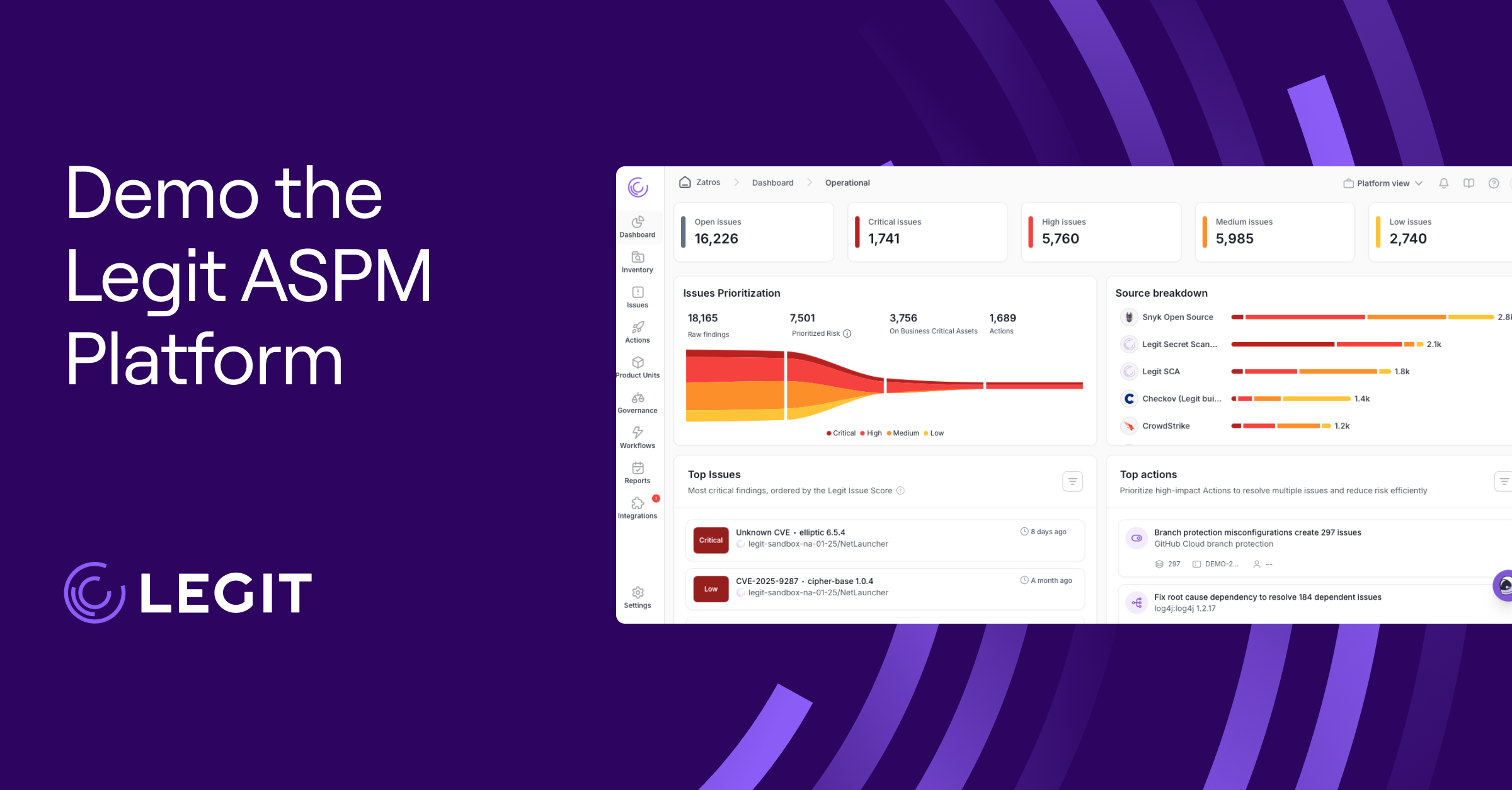Applications rarely operate in isolation. Each depends on a mix of third-party libraries, modules, and tools collectively known as software dependencies to function efficiently.
While this reuse of code accelerates development, it also introduces hidden risks. A single outdated or misconfigured software dependency can affect performance, cause unexpected bugs, or expose your system to security threats.
Here’s a guide to software dependencies, the types you’ll likely encounter, and how to manage them effectively. Plus, learn how Legit Security can help you maintain stability and reduce risk across your projects.
What Are Dependencies in Code?
A software dependency is any external component your application relies on to work as expected. This can include libraries, frameworks, APIs, or other services that add functionality or streamline development.
Instead of reinventing the wheel, developers integrate these tools to save time and build more capable software. But each dependency forms a link in a larger system. If one breaks, becomes outdated, or introduces a bug, it can affect the entire application.
Most dependencies fall into two categories: internal and external. Internal dependencies are connections between different modules within the same application. External ones are common and come from third-party sources like open-source packages or vendor libraries. These include tools like NumPy for data analysis in Python, Lodash for utility functions in JavaScript, Spring Framework for Java applications, or the AWS SDK for cloud integration.
What Are the Different Types of Software Dependencies?
Developers often categorize dependencies as internal or external, but it’s more important to distinguish between direct and transitive dependencies from a security standpoint. These categories are based on how they’re introduced into a project and how they impact your codebase.
Direct Dependencies
Direct dependencies are the libraries, frameworks, or components your project explicitly uses and references in its code. You install them intentionally, like listing them in a configuration file (package.json, requirements.txt, or pom.xml) or importing them directly into your source code. These dependencies are essential for your software to function and are often core to its features, such as authentication modules, logging libraries, dependency injection frameworks, or front-end frameworks.
Because these dependencies are tightly integrated, development teams typically understand them quite well. But that doesn’t make them risk-free. If a direct dependency has a breaking change in a new release, lacks critical bug fixes, or becomes deprecated, it can immediately cause runtime failures or introduce vulnerabilities into your application.
Transitive Dependencies
A transitive dependency is any component that your direct dependencies rely on, even if your code doesn’t use it directly. For instance, when your project depends on Package A, and that package pulls in Package B, your project indirectly relies on Package B—a transitive dependency.
Build tools, package managers, and automation systems automatically pull in these dependencies, which means developers can easily overlook them. A flaw in a transitive dependency can expose your application without you realizing it.
As these dependency relationships form complex chains, they can become harder to monitor, making tools and visibility indispensable to keeping your software stack secure and predictable. A software bill of materials (SBOM) can help you track and document all direct and transitive dependencies so nothing slips through the cracks.
What Is Software Dependency Management?
Managing dependencies is just as important as writing your code—because a single outdated or vulnerable component can break your build, expose your app to threats, or silently introduce bugs you didn’t write.
Software dependency management involves identifying, monitoring, and maintaining the external components your software relies on, such as open-source libraries and vendor packages. You don’t need to avoid dependencies altogether—you need to track the ones you use and make sure they’re secure and up to date. This helps prevent version conflicts, compatibility issues, security vulnerabilities, and other problems that can silently creep in as software evolves.
Managing dependencies keeps your code lean, avoids duplication, and allows teams to standardize on trusted, tested components. The goal is to improve software quality and performance without too much effort. But manual tracking becomes impossible as projects grow in complexity and scale.
That’s where package managers, scanning tools, and strong SBOM management practices come into play. These tools give teams visibility into what’s being used and how it changes, keeping development fast without sacrificing control.
How to Manage Software Dependencies: 5 Best Practices
You can’t manage what you can’t see, and as dependency trees grow, visibility becomes critical. Here are five ways to keep your dependencies under control and your software stable as it scales:
1. Use Package Managers
Package managers like PIP, Maven, or Gradle make it easier to install and remove dependencies in a structured, repeatable way. Instead of manually downloading libraries, you define what you need in a config file and the tool handles the rest. As a result, you reduce manual errors, accelerate setup across development environments, and achieve seamless integration with build automation workflows.
Still, not all packages are created equal. Dependency management starts with choosing well-maintained, trustworthy libraries and avoiding outdated or obscure options that could introduce hidden risks.
2. Pin Dependency Versions and Implement Proper Versioning
Version pinning locks your project to known, tested versions of its dependencies. This helps avoid the chaos of “dependency hell,” where different parts of your project rely on incompatible versions of the same library.
By explicitly defining versions, you can prevent unwanted changes from sneaking in during updates and ensure compatibility across different environments. It’s a simple way to maintain stability while keeping future upgrades on your terms.
3. Use Lockfiles and Isolated Environments
While version pinning helps control direct dependencies, it doesn’t fully lock down your environment. Lockfiles like package-lock.json (for Node.js projects) or Pipfile.lock go further by capturing the exact versions of direct and transitive dependencies, making sure every install is identical across systems.
Combined with virtual environments or containers, lockfiles also help isolate projects from each other and from system-level dependencies. This prevents version clashes or unexpected behavior.
4. Perform Regular Audits and Scanning
Even well-chosen dependencies develop vulnerabilities over time. Scanning for outdated or risky libraries helps catch issues early. Tools like software composition analysis (SCA) automatically flag known common vulnerabilities and exposures (CVEs), license conflicts, and security risks even in transitive dependencies.
A reliable dependency management tool can centralize this process, automating scans and surfacing issues before they reach production. Many of these tools integrate directly into your CI/CD pipeline, making continuous auditing part of the development flow.
5. Map and Document Your Dependency Tree
Most teams underestimate the number of libraries their software truly relies on. Creating a dependency map that visualizes dependency relationships—showing which components depend on what and how changes might cascade through your system—helps identify hidden risks and streamline maintenance.
A basic inventory of names, versions, and sources can help spot outdated libraries or duplication across services. Because dependency trees change frequently, teams should treat documentation as a living resource. It’s a step toward securing your full software supply chain, especially with broader risk management best practices.
Secure Your Software Dependencies With Legit Security
Modern dependency programming relies heavily on software dependencies, but they can create more risk than value without proper management. From direct and transitive libraries to third-party tools and nested packages, every component you add increases your attack surface. That’s why managing dependencies is about keeping them secure, stable, and scalable.
Legit Security helps you do precisely that. By giving you visibility into your software dependency graph and detecting issues early in the software development lifecycle (SDLC), Legit enables teams to enforce secure development practices without slowing down delivery. You can spot untracked components, monitor for version drift, and identify risky packages before they become problematic within your existing workflows.
Whether scaling fast or tightening supply chain controls, software dependency management is a team effort. Legit Security gives you the tools to stay ahead. Request a demo today.
Download our new whitepaper.


